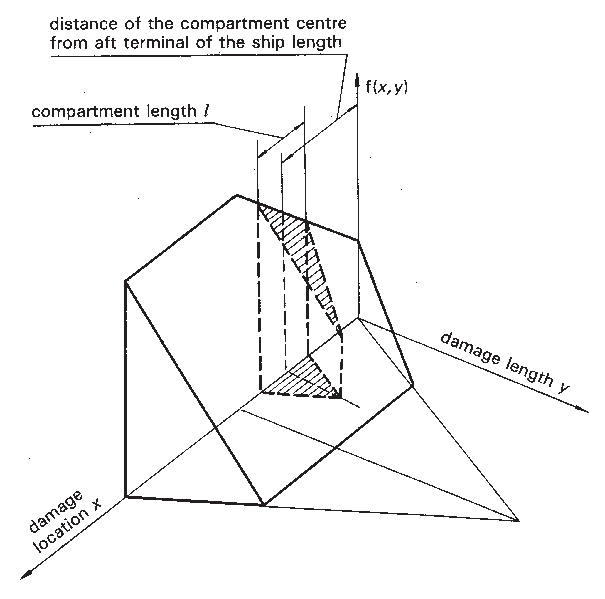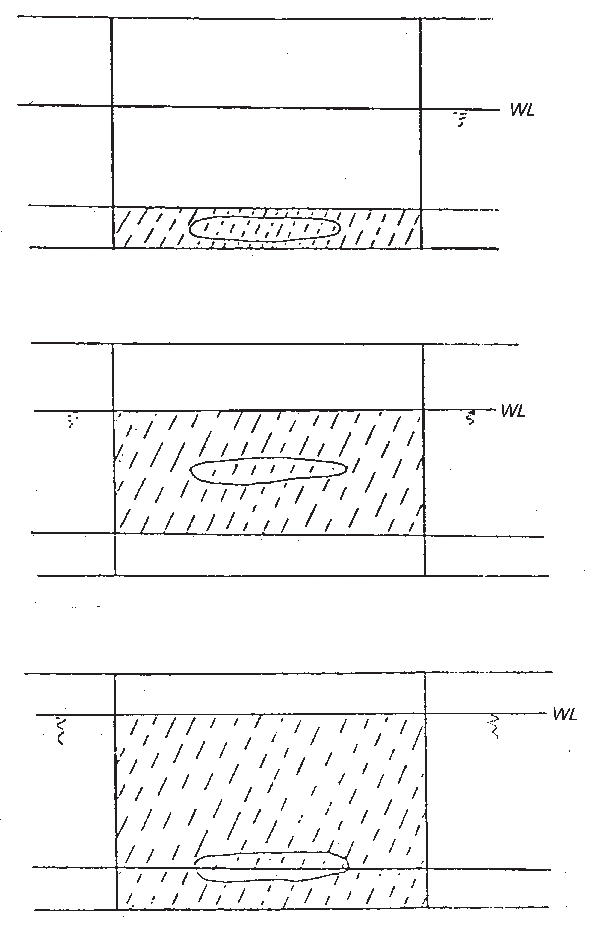The simplest case is to consider the location and length
of damage in the longitudinal direction. This would be sufficient
for ships with no longitudinal and horizontal watertight structural
divisions.
With the damage location x and damage length y as defined in Figure 1,
all possible damages can be represented by points in a triangle which
is also shown in this figure.

Figure 1 Longitudinal damage location triangle
All damages which open single compartments of length l
i are represented in Figure
1 by points in triangles with the base l
i.
Triangles with the base l
i+ l
j (where j = i+1) enclose points corresponding to damages
opening either compartment i, or compartment j,
or both of them. Correspondingly, the points in the parallelogram ij represent damages which open both the compartments i and j.
Damage location x and damage length y are
random variables. Their distribution density f(x,y) can
be derived from the damage statistics. The meaning of f(x,y)
is as follows (see Figure 2):
the total volume between the x-y plane and the surface
given by f(x,y) equals one and represents the probability
that there is damage (this has been assumed to be certain). The volume
above a triangle corresponding to damage which opens a compartment
represents the probability that this compartment is opened. In a similar
manner for all areas in the x-y plane which correspond
to the opening of compartments or group of compartments, there are
volumes which represent the probability that the considered compartments
or group of compartments are opened.

Figure 2 3-Dimensional representation of damaged compartment
The probability that a compartment or a group of adjacent
compartments is opened is expressed by the factor p
i as
calculated according to Regulation
25-5.
Consideration of damage location x and damage
length y only would be fully correct in the case of ships
with pure transverse subdivision. However, there are very few, if
any, such ships - all normally have a double bottom, at least.
In such a case, the probability of flooding a compartment
should be split up into the following three components: probability
of flooding the double bottom only, probability of flooding the space
above the double bottom only and probability of flooding both the
space above and the double bottom itself (see Figure 3). For each of these cases
there may be a different probability that the ship will survive in
the flooded condition. A way out of this dilemma, which may be used
in applying these new regulations, is to assume that the most unfavourable
vertical extent of damage (out of the three possibilities) occurs
with the total probability p. Therefore the contribution
to survival probability made by more favourable cases is neglected.
That the concept is still meaningful for comparative purposes follows
from the fact that the error made by neglecting favourable effects
of horizontal subdivision is not great and the more important influence
of longitudinal damage location and extension is fully covered.

Figure 3 Flooding of a compartment showing the 3 components of
probability
Some examples for dealing with other cases of horizontal
subdivision are given in appendix
1.